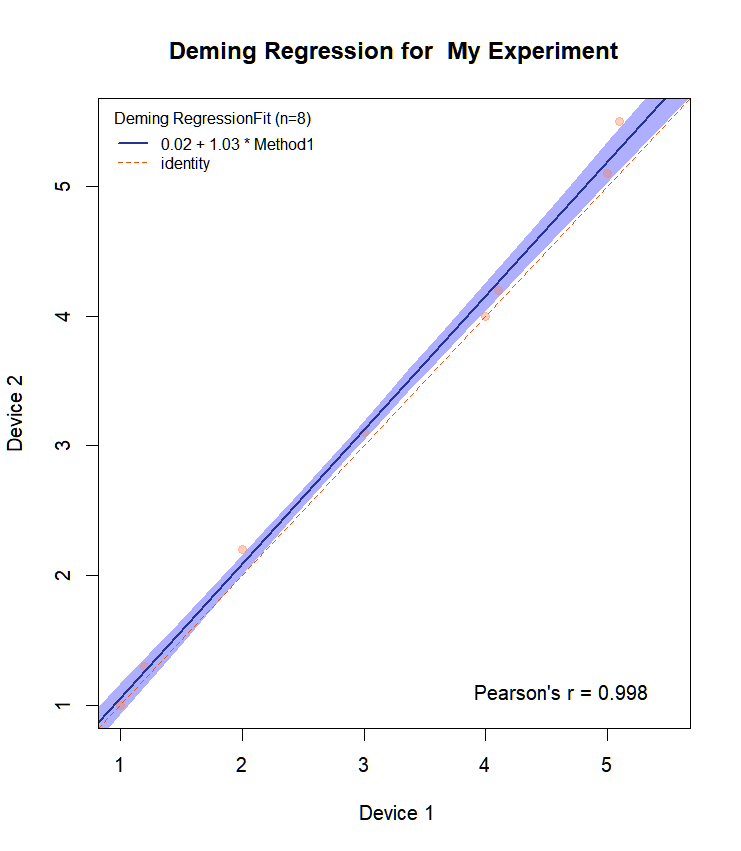
我们都知道常见的 OLS 线性回归模型。在这类模型中,我们假定 Y 与某个连续的预测因子 X 呈线性关系,并将 Y 的测量误差计为:
Y_i=A+B*X_i、
i 是 X 和 Y 上第 i 个观测值的索引。
请注意,从这个回归模型中,由于只有一个预测因子,线性相关系数 R 可以估算为
r=R=sqrt(R^2)。
还要注意的是,检验 H0:r=0 等于检验 H0:B=0。
例如,X 可以是第 i 个学生的学习时间,X 可以是他/她的考试分数。
理想情况下,X 越长,Y 越高,因此 B 系数应该是正数。
在 R 中拟合该模型的方法是使用函数:
lm(Y~X, data=my.data)但是,如果我们要比较 Dev1 和 Dev2 这两个设备呢?我们对 Dev1 和 Dev2 进行相同的测量。结果我们得到了 Dev1 (X1) 和 Dev2 (X2) 的测量向量。评估这两台机器之间一致性的方法就是所谓的戴明回归。这种回归类似于 OLS 回归,但它假定 Y 和 X 的测量都存在误差。
因此,对于第一个设备 Dev1,我们可以得出
X1_i=A1+B1*TrueX1_i+E2_i
第二个设备是 DEV2:
X2_i=A2+B2*TrueX2_i+E2_i.
在上述公式中,E1 和 E2 是测量误差。
我们假设这些误差向量呈正态分布,分别为 N(0,sigma1^2) 和 N(0,sigma2^2)。此外,我们还定义了 lambda=sigma1^2/sigma2^2。
lambda 是两个测量误差方差的比值。通常情况下,我们假设 lambda=1,这样所有机器都不会出现偏差。在 R 中拟合戴明回归的方法是通过软件包 mcr.
下面我编写了一个函数,用于绘制通过 mcreg 函数拟合的戴明回归结果。
它还会返回从模型中得到的斜率和截距。
Draw.Deming.Plot<-function(resp1,resp2,name1){
#mcreg 不接受 NA
df<-as.data.frame(cbind(resp1,resp2))
df2<-df[complete.cases(df),]
dem.reg <- mcreg(df2$resp1,df2$resp2, error.ratio = 1, method.reg = "Deming")
MCResult.plot(dem.reg, equal.axis = TRUE, x.lab = " 设备 1", y.lab = "设备 2", points.col = "#FF7F5060", points.pch = 19, ci.area = TRUE, ci.area.col = "#0000FF50", main = paste("Deming Regression for ",name1), sub = "", add.grid = FALSE, points.cex = 1)
return(list(intercept=c(dem.reg@para[1,c(1,3,4)]),slope=c(dem.reg@para[2,c(1,3,4)]))
}
让我们看看针对示例数据 resp1 和 resp2 绘制的曲线图。
resp1<-c(1,1.2,2,3,4,4.1,5,5.1)
resp2<-c(1,1.3,2.2,3.1,4,4.2,5.1,5.5)
Draw.Deming.Plot(resp1,resp2, "My Experiment")
我们得到
$intercept
EST LCI UCI
0.01532475 -0.18087790 0.19446184
$slope
EST LCI UCI
1.0345434 0.9672911 1.0910989 还有情节:

我们注意到,对于这个玩具数据来说,上述一致性几乎是完美的。斜率等于 1,置信区间为 0.97-1.09。函数 MCResult.plot 默认也用所选颜色绘制置信区间。它还会在图中标出方程。
如果想把斜率和截距的 CI 也放在图上,下面是对 MCResult.plot() 函数的修改:
MCResult.plot2 0 & alpha = length(names(digits)))
如果 (is.null(digits$coef)) {
digits$coef <- 2
}
如果 (is.null(digits$cor)) {
digits$cor <- 3
}
cor.method <- match.arg(cor.method)
stopifnot(is.element(cor.method, c("pearson", "kendall"、
"spearman"))
legend.place 1)
stopifnot(length(points.col) == nrow(x@data))
if (length(points.pch) > 1)
stopifnot(length(points.pch) == nrow(x@data))
if (x@regmeth == "LinReg")
titname <- "线性回归"
else if (x@regmeth == "WLinReg")
titname <- "加权线性回归"
else if (x@regmeth == "TS")
titname <- "Theil-Sen 回归"
else if (x@regmeth == "PBequi")
titname <- "等变传递-Bablok 回归"
else if (x@regmeth == "Deming")
titname <- "戴明回归"
else if (x@regmeth == "WDeming")
titname <- "加权戴明回归"
else titname <- "传递巴布洛克回归"
niceblue <- rgb(37/255, 52/255, 148/255)
niceor <- rgb(230/255, 85/255, 13/255)
niceblue.bounds <- rgb(236/255, 231/255, 242/255)
if (is.null(reg.col))
reg.col <- niceblue
if (is.null(identity.col))
identity.col <- niceor
if (is.null(ci.area.col))
ci.area.col <- niceblue.bounds
if (is.null(ci.border.col))
ci.border.col 1)
if (is.null(xlim))
rx <- range(x@data[, "x"], na.rm = TRUE)
else rx <- xlim
tmp.range <- range(as.vector(x@data[, c("x", "y")]), na.rm = TRUE)
if (equal.axis == TRUE) {
if (is.null(ylim)) {
yrange <- tmp.range
}
否则 {
yrange <- ylim
}
}
else {
if (is.null(ylim)) {
yrange <- range(as.vector(x@data[, "y"]), na.rm = TRUE)
}
else {
yrange <- ylim
}
}
if (!is.null(xlim) && !is.null(ylim) && equal.axis) {
xlim <- c(min(c(xlim[1], ylim[1])), max(c(xlim[2], ylim[2])))
}
if (is.null(xaxp)){
if (!is.null(xlim)) {
axis_ticks <- axisTicks(c(xlim[1] - 0.05 * xlim[2]、
ceiling((xlim[2] + 0.05 * xlim[2]) * 10^digits$coef)/10^digits$coef)、
log = F, nint = 7)
xaxp <- c(axis_ticks[1], tail(axis_ticks, n = 1)、
length(axis_ticks) - 1)
xlim <- c(axis_ticks[1], tail(axis_ticks, n = 1))
}
}
否则 {
if (!is.null(xlim)) {
if ((xlim[1] == rx[1] && xlim[2] == rx[2]) | (tmp.range[1] ==
xlim[1] && tmp.range[2] == xlim[2])){
xlim <- c(xaxp[1], xaxp[2])
}
}
否则 {
warning("xaxp 绝不应在没有 xlim 的情况下设置")
xaxp <- NULL
}
}
if (is.null(yaxp)){
if (!is.null(ylim) && !equal.axis) {
yaxp <- axis_ticks <- axisTicks(c(ylim[1] - 0.05 *.
ylim[2], ceiling((ylim[2] + 0.05 * ylim[2]) *
10^digits$coef)/10^digits$coef), log = F, nint = 10)
yaxp = c(axis_ticks[1], tail(axis_ticks, n = 1)、
length(axis_ticks) - 1)
ylim <- c(axis_ticks[1], tail(axis_ticks, n = 1))
}
否则 {
if (equal.axis) {
if (!is.null(xlim)) {
yaxp <- xaxp
ylim <- xlim
}
}
}
}
else {
if (!is.null(ylim)) {
如果 ((ylim[1] == yrange[1] && ylim[2] == yrange[2]) |
(tmp.range[1] == ylim[1] && tmp.range[2] == ylim[2])){
ylim <- c(yaxp[1], yaxp[2])
}
}
否则 {
warning("yaxp 不应在没有 ylim 的情况下设置")
yaxp <- NULL
}
}
if (equal.axis) {
if (is.null(ylim)) {
yaxp <- xaxp
ylim <- xlim
}
if (is.null(xlim)) {
xaxp <- yaxp
xlim <- ylim
}
}
if (!is.null(xlim)) {
if (xlim[1] < tmp.range[1]) {
tmp.range[1] tmp.range[2]) {
tmp.range[2] <- xlim[2]
}
}
if (!is.null(ylim)) {
if (ylim[1] < yrange[1]) {
yrange[1] yrange[2]) {
yrange[2] yrange[2])
}
}
xd <- seq(rx[1], rx[2], length.out = xn)
xd <- union(xd, rx)
delta <- abs(rx[1] - rx[2])/xn
xd <- xd[order(xd)]
xd.add <- c(xd[1] - delta * 1:10, xd, xd[length(xd)] + delta * 1:10)
1:10)
if (is.null(xlim))
xlim <- rx
if (ci.area == TRUE | ci.border == TRUE) {
bounds <- calcResponse(x, alpha = alpha, x.levels = xd)
bounds.add <- calcResponse(x, alpha = alpha, x.levels = xd.add)
if (equal.axis == TRUE) {
xd <- seq(tmp.range[1], tmp.range[2], length.out = xn)
xd <- union(xd, tmp.range)
delta <- abs(rx[1] - rx[2])/xn
xd <- xd[order(xd)]
xd.add <- c(xd[1] - delta * 1:10, xd, xd[length(xd)] +
delta * 1:10)
bounds <- calcResponse(x, alpha = alpha, x.levels = xd)
bounds.add <- calcResponse(x, alpha = alpha, x.levels = xd.add)
yrange <- range(c(as.vector(x@data[, c("x", "y")])、
as.vector(bounds[, c("X", "Y", "Y.LCI", "Y.UCI")])、
na.rm = TRUE)
}
else {
yrange <- range(c(as.vector(x@data[, "y"]), as.vector(bounds[、
c("Y", "Y.LCI", "Y.UCI")]), na.rm = TRUE)
}
}
否则 {
if (equal.axis == TRUE) {
yrange <- tmp.range
}
else {
yrange <- range(as.vector(x@data[, "y"]), na.rm = TRUE)
}
}
if (equal.axis) {
if (is.null(ylim)) {
xlim <- ylim <- tmp.range
}
else {
xlim <- ylim
}
}
else {
if (is.null(xlim))
xlim <- rx
if (is.null(ylim))
ylim <- yrange
}
if (is.null(main))
main <- paste(titname, "Fit")
if (!add) {
plot(0, 0, cex = 0, ylim = ylim, xlim = xlim, xlab = x.lab、
ylab = y.lab, main = main, sub = "", xaxp = xaxp、
yaxp = yaxp, bty = "n", ...)
}
else {
sub <- ""
add.legend <- FALSE
add.grid <- FALSE
}
if (add.legend == TRUE) {
if (identity == TRUE & reg == TRUE) {
text2 <- "身份"
text1 <- paste(formatC(round(x@para["Intercept"、
"EST"], digits = digits$coef), digits = digits$coef、
format = "f"),"(",formatC(round(x@para["Intercept"、
"LCI"], digits = digits$coef), digits = digits$coef、
format = "f"),";",formatC(round(x@para["Intercept"、
"UCI"], digits = digits$coef), digits = digits$coef、
format = "f"),")"," + ", formatC(round(x@para["Slope"、
"EST"], digits = digits$coef), digits = digits$coef、
format = "f"),"(",formatC(round(x@para["Slope"、
"LCI"], digits = digits$coef), digits = digits$coef、
format = "f"),";",formatC(round(x@para["Slope"、
"UCI"], digits = digits$coef), digits = digits$coef、
format = "f"),")"," * ", x@mnames[1], sep = "")
legend(legend.place, lwd = c(reg.lwd, identity.lwd)、
lty = c(reg.lty, identity.lty), col = c(reg.col、
identity.col), title = paste(titname, "Fit (n="、
dim(x@data)[1], ")", sep = ""), legend = c(text1、
text2), box.lty = "blank", cex = 0.8, bg = "white"、
inset = c(0.01, 0.01))
}
if (identity == TRUE & reg == FALSE) {
text2 <- "身份"
legend(legend.place, lwd = identity.lwd, lty = identity.lty、
col = identity.col, title = paste(titname, "Fit (n="、
dim(x@data)[1], ")", sep = ""), legend = text2、
box.lty = "blank", cex = 0.8, bg = "white", inset = c(0.01、
0.01))
}
if (identity == FALSE & reg == TRUE) {
text1 <- paste(formatC(round(x@para["Intercept"、
"EST"], digits = digits$coef), digits = digits$coef、
format = "f"), "+", formatC(round(x@para["Slope"、
"EST"],digits = digits$coef),digits = digits$coef、
format = "f"), "*", x@mnames[1], sep = "")
legend(legend.place, lwd = c(2), col = c(reg.col)、
title = paste(titname, "Fit (n=", dim(x@data)[1]、
")", sep = ""), legend = c(text1), box.lty = "blank"、
cex = 0.8, bg = "white", inset = c(0.01, 0.01))
}
}
if (ci.area == TRUE | ci.border == TRUE) {
if (ci.area == TRUE) {
xxx <- c(xd.add, xd.add[order(xd.add, decreasing = TRUE)])
yy1 <- c(as.vector(bounds.add[, "Y.LCI"]))
yy2 <- c(as.vector(bounds.add[, "Y.UCI"]))
yyy <- c(yy1, yy2[order(xd.add, decreasing = TRUE)])
polygon(xxx, yyy, col = ci.area.col, border = "white"、
lty = 0)
}
if (add.grid)
网格()
if (ci.border == TRUE) {
points(xd.add, bounds.add[, "Y.LCI"], lty = ci.border.lty、
lwd = ci.border.lwd,type = "l",col = ci.border.col)
points(xd.add, bounds.add[, "Y.UCI"], lty = ci.border.lty、
lwd = ci.border.lwd,type = "l",col = ci.border.col)
}
if (is.null(sub)) {
if (x@cimeth %in% c("bootstrap", "nestedbootstrap"))
subtext <- paste("The ", 1 - x@alpha, "-confidence bounds are calculated with the "、
x@cimeth, "(", x@bootcimeth, ") 方法计算。", sep = "")
else if ((x@regmeth =="PaBa") & (x@cimeth =="analytical"))
subtext <- ""
else subtext <- paste("The ", 1 - x@alpha, "-confidence bounds are calculated with the "、
x@cimeth, " 方法计算。", sep = "")
}
else subtext <- sub
}
else {
if (add.grid)
grid()
subtext <- ifelse(is.null(sub), "", sub)
}
if (add.cor == TRUE) {
cor.coef <- paste(formatC(round(cor(x@data[, "x"], x@data[、
"y"], use = "pairwise.complete.obs", method = cor.method)、
digits = digits$cor), digits = digits$cor, format = "f"))
if (cor.method == "pearson")
cortext <- paste("Pearson's r = ", cor.coef, sep = "")
if (cor.method == "kendall")
cortext <- bquote(paste("Kendall's ", tau, " = "、
.(cor.coef), sep = ""))
if (cor.method == "spearman")
cortext <- bquote(paste("Spearman's ", rho, " = "、
.(cor.coef), sep = ""))
mtext(side = 1, line = -2, cortext, adj = 0.9, font = 1)
}
if (draw.points == TRUE) {
points(x@data[, 2:3], col = points.col, pch = points.pch、
cex = points.cex, ...)
}
title(sub = subtext)
if (reg == TRUE) {
b0 <- x@para["Intercept", "EST"]
b1 <- x@para["斜率", "EST"]
abline(b0, b1, lty = reg.lty, lwd = reg.lwd, col = reg.col)
}
if (identity == TRUE) {
abline(0, 1, lty = identity.lty, lwd = identity.lwd、
col = identity.col)
}
box()
}
如果我们现在改变函数
Draw.Deming.Plot<-function(resp1,resp2,name1){
#mcreg 不接受 NA
df<-as.data.frame(cbind(resp1,resp2))
df2<-df[complete.cases(df),]
dem.reg <- mcreg(df2$resp1,df2$resp2, error.ratio = 1, method.reg = "Deming")
MCResult.plot2(dem.reg, equal.axis = TRUE, x.lab = " 设备 1", y.lab = "设备 2", points.col = "#FF7F5060", points.pch = 19, ci.area = TRUE, ci.area.col = "#0000FF50", main = paste("Deming Regression for ",name1), sub = "", add.grid = FALSE, points.cex = 1)
return(list(intercept=c(dem.reg@para[1,c(1,3,4)]),slope=c(dem.reg@para[2,c(1,3,4)]))
}我们呼叫
Draw.Deming.Plot(resp1,resp2, "My Experiment")然后我们得到

现在,曲线图上的斜率和截距都是 CI。
玩得开心!
